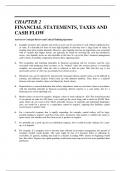CHAPTER 2
FINANCIAL STATEMENTS, TAXES AND
CASH FLOW
Answers to Concepts Review and Critical Thinking Questions
1. Liquidity measures how quickly and easily an asset can be converted to cash without significant loss
in value. It’s desirable for firms to have high liquidity so that they have a large factor of safety in
meeting short-term creditor demands. However, since liquidity also has an opportunity cost associated
with it—namely that higher returns can generally be found by investing the cash into productive
assets—low liquidity levels are also desirable to the firm. It’s up to the firm’s financial management
staff to find a reasonable compromise between these opposing needs.
2. The recognition and matching principles in financial accounting call for revenues, and the costs
associated with producing those revenues, to be “booked” when the revenue process is essentially
complete, not necessarily when the cash is collected or bills are paid. Note that this way is not
necessarily correct; it’s the way accountants have chosen to do it.
3. Historical costs can be objectively and precisely measured whereas market values can be difficult to
estimate, and different analysts would come up with different numbers. Thus, there is a tradeoff
between relevance (market values) and objectivity (book values).
4. Depreciation is a noncash deduction that reflects adjustments made in asset book values in accordance
with the matching principle in financial accounting. Interest expense is a cash outlay, but it’s a
financing cost, not an operating cost.
5. Market values can never be negative. Imagine a share of stock selling for –$20. This would mean that
if you placed an order for 100 shares, you would get the stock along with a check for $2,000. How
many shares do you want to buy? More generally, because of corporate and individual bankruptcy
laws, net worth for a person or a corporation cannot be negative, implying that liabilities cannot
exceed assets in market value.
6. For a successful company that is rapidly expanding, for example, capital outlays will be large,
possibly leading to negative cash flow from assets. In general, what matters is whether the money is
spent wisely, not whether cash flow from assets is positive or negative.
7. It’s probably not a good sign for an established company, but it would be fairly ordinary for a start-
up, so it depends.
8. For example, if a company were to become more efficient in inventory management, the amount of
inventory needed would decline. The same might be true if it becomes better at collecting its
receivables. In general, anything that leads to a decline in ending NWC relative to beginning would
have this effect. Negative net capital spending would mean more long-lived assets were liquidated than
purchased.
, B-4 SOLUTIONS
9. If a company raises more money from selling stock than it pays in dividends in a particular period, its
cash flow to stockholders will be negative. If a company borrows more than it pays in interest, its cash
flow to creditors will be negative.
10. The adjustments discussed were purely accounting changes; they had no cash flow or market value
consequences unless the new accounting information caused stockholders to revalue the derivatives.
Solutions to Questions and Problems
Basic
1. Balance Sheet
CA $3,000 CL $900 OE = $9,000 – 5,900 = $3,100
NFA 6,000 LTD 5,000 NWC = $3,000 – 900 = $2,100
TA $9,000 OE 3,100
TL + OE $9,000
2. Income Statement
Sales $432,000
Costs 210,000
Depreciation 25,000
EBIT $197,000
Interest 8,000
EBT $189,000
Taxes 66,150
Net income $122,850
3. Net income = divs + add. to ret. earnings; add. to ret. earnings = $122,850 – 65,000 = $57,850
4. EPS = NI / shares = $122,,000 = $4.10 per share
DPS = divs / shares = $65,,000 = $2.17 per share
5. NWC = CA – CL; CA = $900K + 1.8M = $2.7M
Book value CA = $2.7M Market value CA = $2.9M
Book value NFA = $1.6M Market value NFA = $1.5M
Book value assets = $2.7M + 1.6M = $4.3M Market value assets = $2.9M + 1.5M = $4.4M
6. Taxes = 0.15($50K) + 0.25($25K) + 0.34($25K) + 0.39($185K – 100K) = $55,400
7. Average tax rate = $55,400 / $185,000 = 29.95%; marginal tax rate = 39%




